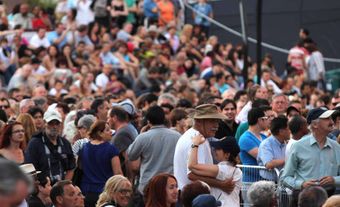Sarnia, Ont
Sarnia, Ont. Ontario city settled in 1807. It was known first as Fort Rapids, later as Port Sarnia, and in 1856 it was incorporated as the town of Sarnia. It became a city in 1914. Its population was 49,033 in 1986. Sarnia is located on the St Clair River just south of Lake Huron and opposite Port Huron, Mich. Immediately to the south lies 'Chemical Valley,' Canada's greatest concentration of petro-chemical industries.
Church and band music preoccupied Sarnia's first musicians. At St Andrew's Presbyterian Church, which had a choir soon after it opened in 1841, Francis Laird led congregational singing classes 1861-77. After years of argument about the propriety of instrumental music in the church, St Andrew's installed an organ in 1883. Its first organist, A.A. Clappé, had become conductor of the Sarnia Citizens' Band in 1879. He was also a teacher, the conductor of the Mozart Choral Union, and bandmaster of the 27th Battalion Band. About 1884 he left for the USA.
In 1910 the 130-voice combined choirs of St Andrew's Presbyterian and St George's Anglican churches, with soloists from Toronto, performed Messiah under Charles Patchett, organist at St George's 1904-41. Other pioneers were the organist and bandmaster William Philp and his successor (1910) as leader of the Citizens' Band, W.E. Brush. Brush also conducted several other local military, church, and school bands.
Before World War I most of Sarnia's secular musical ensembles were bands. The Sarnia Garrison Band (later the Lambton Regimental Band), formed in 1875, was followed by the Citizens' and 149th bands. The Sons of Scotland Highland Pipe Band, formed in 1910, enlisted en masse in the 70th Battalion in 1915 and re-formed after the war as the Imperial Pipe Band.
Among organizations performing between the two world wars were a Sarnia SO (formed in 1915), a Sarnia Male Chorus (formed in 1919; its accompanist, Mrs A.W. Mills, was also an organist at Central Baptist Church), an Imperial Theatre Orchestra (Sarnia, Ont) (formed 1919), a Philharmonic Choral Society (formed 1920 to perform Gilbert & Sullivan), and a Sarnia Orchestra (formed in 1938).
Choral groups which have existed in Sarnia have included the Polysar (formerly Polymer) Glee Club which began to present musicals in 1947; the Solo Deo Choir, formed in 1951 by the active Dutch community; the Tudor (formerly David Stone) Singers, formed in 1961; and the Art Christmas Aggregation, formed in 1975.
A significant post-war development was the Sarnia Little Symphony Society, organized in 1950 under Walter Stern and amalgamated in 1956 with the Port Huron (Mich) String Ensemble. Renamed the International Symphony Orchestra of Sarnia and Port Huron it made its debut in 1957 and in 1990 continued to perform in the USA and Canada. Until 1974 (see Sault Ste Marie) it was the only adult community orchestra in North America with players and board members from both sides of the border (see Orchestras).
Organizations which have brought visiting artists to Sarnia include the Musical Literary Society (1895-8), the Women's Tuesday Musical (fl 1907-16, 1919-28), the Sarnia Music Club (formed in 1935 and later renamed the Sarnia Music and Drama Association), and the Sarnia Community Concerts Association which has presented Canadian and non-Canadian soloists and ensembles of stature, including Pierrette Alarie and Leopold Simoneau, Rose Bampton, Victor Bouchard and René Morisset, the COC, Clifford Curzon, Eileen Farrell, Maureen Forrester, William Kapell, Lois Marshall, Erica Morini, Leontyne Price, Louis Quilico, Bidú Sayao, Cesare Siepi, Teresa Stratas, the Stuttgart Chamber Orchestra, Ronald Turini, and Portia White.
The Canadian Concert Artist Series, organized in 1962, presented such musicians as Robert Aitken, Lorand Fenyves, Marek Jablonski, Yuri and Dana Mazurkevich, and the Orford String Quartet at the Sarnia Public Library and Art Gallery. In 1991 this series was sponsored by the Arts and Culture Dept of Lambton County, and the concerts were presented in the Lambton Gallery Theatre.
In the early years of the 20th century young musicians received their training from private teachers and from the Sisters of St Joseph Music School, which opened in 1905. In 1928 Sarnia music teachers organized the Lambton chapter of the OMTA, which in 1946 became the Sarnia branch of the ORMTA. This organization promoted music instruction in the schools, set up the Lambton County Music Festival (in 1930), and sponsored recitals, workshops, and lectures. A Sarnia chapter of the RCCO was established in 1953. In 1988 Dow Chemical Canada opened the People Place to feature outdoor popular summer entertainment. The Festival by the Bay, a folk festival organized by the Centre for Entertainment and the Environment (started 1985), was initiated in 1990.
Brian Barley and R. Murray Schafer were born in Sarnia. Other musicians who have lived in or near Sarnia and contributed to its musical life have included Gwen Beamish MacMillan, Mike Stevens (harmonica), and Irene Harrington Young (children's piano works). The rock band Max Webster, which came to prominence in 1976, was formed in Sarnia.

 Share on Facebook
Share on Facebook Share on X
Share on X Share by Email
Share by Email Share on Google Classroom
Share on Google Classroom

